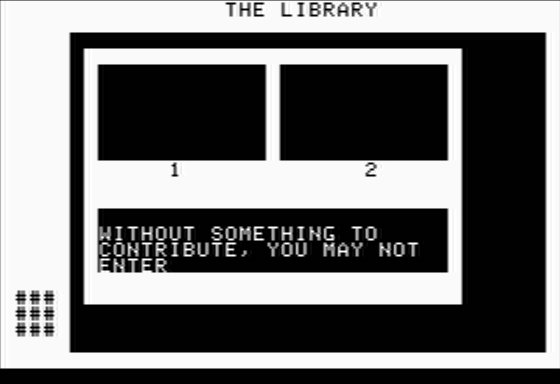Retro Replay Review
Gameplay
The Prisoner’s gameplay revolves entirely around text-based exploration and puzzle-solving, drawing players into a series of metaphorical quests that reflect the oppressive atmosphere of the titular Island. Each building you enter serves as a symbolic challenge—whether it’s a seemingly innocuous boutique or a sinister hospital ward—tasking you with creative problem-solving rather than brute force or reflexes. Success hinges on deciphering subtle clues woven into the narrative, ensuring that each victory feels earned and thought-provoking.
Interaction with the world is mediated through a language parser, inviting you to type commands ranging from simple movements (“go north,” “open door”) to more nuanced interrogations (“ask caretaker why I’m here”). While the parser occasionally struggles with unconventional phrasing, this limitation also reinforces the game’s central theme: communication is a tool that can either liberate or entrap. Players who relish linguistic experimentation will find genuine satisfaction in coaxing the game toward hidden responses and alternate endings.
Progression across the Island is non-linear, allowing you to tackle buildings in the order that suits your style. Some quests reward lateral thinking—combining seemingly unrelated items or leveraging environmental details—while others test your willingness to defy convention. There’s no hand-holding here; hints are cryptic, and failure often sends you back to square one. But for those who thrive on intellectual challenge, each puzzle’s resolution brings a rewarding sense of individual triumph.
Graphics
As a text-based adventure, The Prisoner forgoes elaborate visuals in favor of stark, text-driven imagery. The interface is clean and functional: a monochrome text window framed by minimalistic borders, with occasional graphic flourishes to denote significant events or status changes. This simplicity reinforces the game’s psychological focus, allowing your imagination to flesh out the unsettling environment of the Island.
Despite the lack of traditional graphics, the game employs atmospheric typography and occasional line-art illustrations to evoke the resort-meets-prison aesthetic. When you step into a new building, a succinct ASCII sketch or stylized icon may hint at the room’s purpose—be it therapeutic or torturous. These visual cues, though modest, help ground the narrative in a tangible space and aid in puzzle-solving by offering subtle environmental context.
Sound design is similarly restrained, limited to sparse beeps or ambient background tones that underscore key moments, such as discovering a vital clue or encountering a hostile oversight system. While not a full-fledged audio experience, these aural elements heighten tension without overshadowing the text. For players seeking high-fidelity graphics or immersive soundtracks, The Prisoner’s aesthetic may feel bare-bones; yet its minimalist presentation is precisely what sustains the game’s eerie, introspective mood.
Story
The Prisoner’s narrative draws directly from the cult British television series, placing you in the shoes of a former spy who has mysteriously resigned and been whisked away to the enigmatic Island. From the outset, you’re caught between coercion and autonomy as the faceless powers-that-be probe for your hidden motives. This central tension—maintaining individual thought in the face of relentless scrutiny—drives every interaction and puzzle you encounter.
Each building you explore functions as a narrative vignette, presenting allegorical dilemmas that echo the show’s themes of identity, freedom, and surveillance. Whether you’re manipulated by a deceptive carnival barker or tested by a sinister psychologist, the writing consistently underscores the battle between conformity and self-determination. The game’s prose is sharp and evocative, balancing cryptic hints with occasional humor to prevent the tone from growing overly oppressive.
Ultimately, the heart of the story lies in your confrontation with the Island’s “Caretaker.” Using the parser, you engage in a dialogue that can unlock multiple outcomes—some bleak, others hinting at escape. This conversation is the culmination of all your accumulated wisdom and cunning: only by demonstrating true independent thinking can you pierce the Island’s veil of control. The narrative payoff is both intellectually and emotionally satisfying, rewarding players who have fully embraced the game’s underlying philosophy.
Overall Experience
The Prisoner offers a unique blend of cerebral challenge and immersive storytelling that sets it apart from more conventional adventure games. Its text-based format may deter those accustomed to flashy visuals, but anyone with an appetite for puzzle-driven narratives will find themselves engrossed in the Island’s psychological labyrinth. The game’s pace is deliberately measured, encouraging thoughtful exploration rather than hasty decision-making.
Longevity comes from the desire to uncover every hidden path and dialogue branch, and the satisfaction of piecing together the Island’s deeper mysteries. While some may find the parser’s occasional rigidity frustrating, it also adds to the sense of real-world linguistic nuance—every choice of wording matters. For players willing to engage on the game’s terms, The Prisoner delivers a richly layered experience that lingers long after you’ve powered down your computer.
In sum, The Prisoner is a must-play for fans of narrative-driven adventures and psychological thrillers. Its minimalist presentation belies the depth of its design, and its thematic resonance will appeal to anyone intrigued by questions of autonomy and authority. Whether you’re drawn in by the cult television legacy or by your own penchant for devious puzzles, the Island awaits—and only the most determined thinkers will earn their freedom.
 Retro Replay Retro Replay gaming reviews, news, emulation, geek stuff and more!
Retro Replay Retro Replay gaming reviews, news, emulation, geek stuff and more!









Reviews
There are no reviews yet.